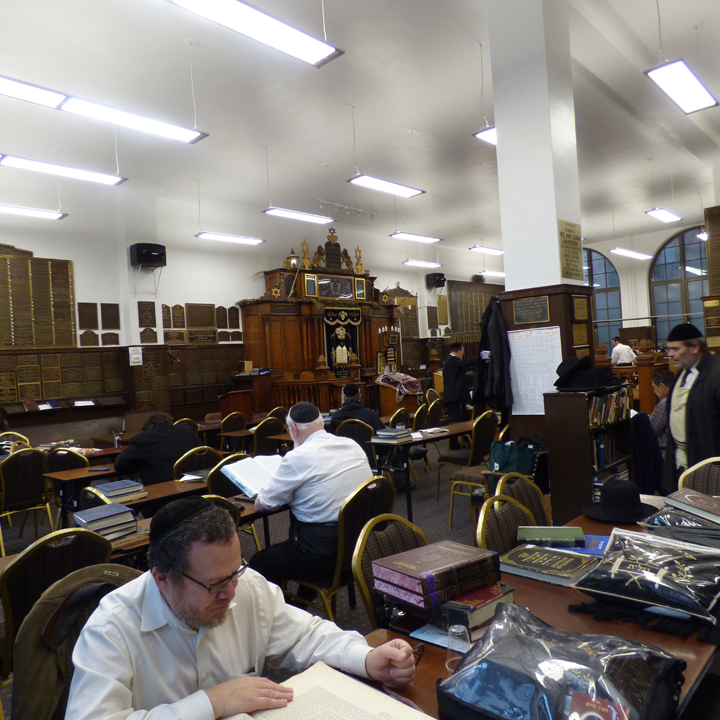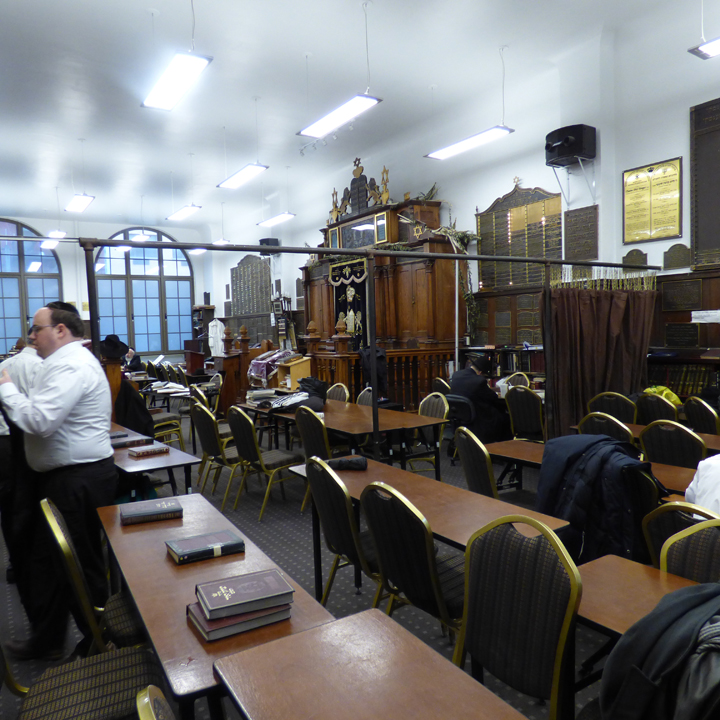The careful and muted sound
Of a fruit falling from the tree
Amidst the unbroken singing
Of deep silence of the forest . . .
Mandelshtam
December 2015
For the last four years, I have spent much of my free time studying Talmud at Mesivtha Tifereth Jerusalem (MTJ), the yeshiva on New York’s Lower East Side where, for decades, Reb Dovid Feinstein has presided as rosh yeshiva. MTJ includes a lower school along with an advanced study hall, or bes medresh, which is where I study. The bes medresh is a large, roughly square, high-ceilinged room, with huge windows on two sides, one of those sides opening onto East Broadway. Unlike some yeshivas where students all face the front of the room, at MTJ we sit at tables, and study pairs or chevruses generally face each other rather than sitting across from each other. My place is in the corner of the bes medresh closest to the entrance and the street. Opposite, facing the interior courtyard, another corner has been closed off to form a separate library room. Reb Dovid’s daily 11:00 a.m. Talmud shi’ur, which I attend, is held in the library. Otherwise, I am mostly preparing or reviewing, alone or with regular partners, the text covered in the shi’ur—right now, the tractate Bava Kamma.
For the past couple of months, I have attempted to note as sound, and not as semiosis, what I hear at the yeshiva. It is a difficult task since so much of the sound at MTJ consists of discursive textual study, or as I called it elsewhere, “Voices around the Text.” Here are some of my notes, slightly edited and rearranged to help the reader imagine the spaces where these sounds arise or are heard in the course of the study day.
Names are changed per ethnographic convention, though I think there are no secrets here.
Some of the “sentences” below, like Mandelshtam’s poem above, have no verbs. If I could, I would have written this entire piece without verbs. But I am no Mandelshtam.

A sandwich or breakfast roll being unwrapped from a plastic bag behind me.
I can’t tell what he’s saying but it’s Larry Browner’s voice in the opposite corner of the bes medresh, closer to the ’aron kodesh and to the windows facing the courtyard. Hershl Yekhezkl’s voice likewise distinguishable, but not the words, from the library.
Something between a murmur and a cacophony of voices from three to five people in the opposite corner. A young Hasid comes in at the table next to us and learns in a murmur, and continues to do so while his friend has come into the bes medresh and sits down across from him. The background murmur or cacophony gradually grows louder toward 11:00 a.m., as people drift into the bes medresh. The clicking sound made by the legs of two chairs as the Hasid next to me stacks them so he can sit higher. But footsteps walking on the carpet are silent: you see people walking, of course, but you don’t hear them.
The liquid flapping of seforim being removed from the shelves.

The ebb and flow of conversations from several chevrusas reminds me again of the passage in Edmond Jabès’s Book of Questions where he clarifies that Jews at prayer only appear to be standing, and rocking on their feet. Actually, he says, they are prone, and rocking on the waves of the sea. Here, the conversations are the waves, and the words I catch (“Rashi . . . actually . . . sure, but it wasn’t a . . . let’s see the Rashi . . . vayter vayter vayter . . . generally is . . .”) so many bits of foam and spray that detach from the current for a second and then return to it. Even if I do catch some of the words I can’t necessarily tell what’s being studied, since unlike many yeshivas not everyone at MTJ is studying the same text.
My cell phone ringing to pull me out of the rhythm of group study, imperious as the telephone on its stand in the hallway of Walter Benjamin’s childhood home as he describes in his Berlin Childhood around 1900.
Someone’s watch beeps to mark the hour.
At the table behind me, Rabbi Flinker clicks his fingers, whether to get his study partner’s attention or to help stress a logical point.
The quiet rush of local traffic when the window is open on this hideously mild day. Ten minutes later the window bangs shut by itself, an echo of long-ago arguments about whether to keep the window open or not. Then the rustle, like distant traffic or the waves on the seashore, of the air conditioning switched on in mid-December.
As we wait in the library for the shi’ur to begin, Uncle Shlomo points to Zalie Scharf sitting by the wall, where (unlike where I’m positioned) he will not be the first to see the rosh yeshiva as he walks into the room. Shlomo explains: Zalie listens for the sound of the rosh yeshiva’s office door closing, outside the bes medresh and across the hall, where we can’t see it from the library. And apparently it’s true, because Zalie stands up before any of us has heard or seen the rosh yeshiva approaching.
In shi’ur, the rosh yeshiva shows traces of a native Litvak phonology as he reads the words of the Talmud, Rashi, and Tosafos. As a few more people drift in to the shi’ur, the sound of the library door opening and closing, footsteps, slight scraping of chairs.
A scraping sound under the table around which we’re all sitting—I’ve heard it often in shi’ur before. It must be someone scraping his feet on the bars of the table. (It sounds like radiator pipes banging but there’s no radiator there.)
During shi’ur, kids bang on the locked back door of the library leading to the fire escape and thence to the play yard, or try the handle to see if they can get in through a shortcut.
Shuffling of pages as Rebbe refers back to an earlier passage in the Gemara.
As Rebbe works through a difficult analysis in Tosafos that I’m incapable of following, I doze off, trying to catch myself before I begin to snore.
Hershl Yekhezkl’s Gemara rips as he flips back a couple of folios, turning them by the bottom of the page.
Later, as everyone stands, facing the ’aron kodesh and (roughly) east for the Minḥah prayer, coins jingle in a tzedakah box borne by my study partner.
The loudest sound of the day, quite likely, is the collective response “yehey shmey rabbo . . .” during the Kedushah.
After lunch, the sound of trop as someone reviews the Torah reading for the coming Sabbath.

